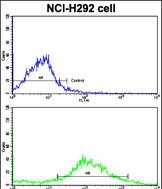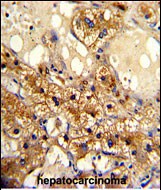


| WB | 咨询技术 | Human,Mouse,Rat |
| IF | 咨询技术 | Human,Mouse,Rat |
| IHC | 1/100-1/500 | Human,Mouse,Rat |
| ICC | 技术咨询 | Human,Mouse,Rat |
| FCM | 1/10-1/50 | Human,Mouse,Rat |
| Elisa | 咨询技术 | Human,Mouse,Rat |
| Aliases | Cytochrome P450 20A1, 114--, CYP20A1 |
| Entrez GeneID | 57404 |
| WB Predicted band size | 52.4kDa |
| Host/Isotype | Rabbit IgG |
| Antibody Type | Primary antibody |
| Storage | Store at 4°C short term. Aliquot and store at -20°C long term. Avoid freeze/thaw cycles. |
| Species Reactivity | Human |
| Immunogen | This CYP20A1 antibody is generated from rabbits immunized with a KLH conjugated synthetic peptide between 364-392 amino acids from the C-terminal region of human CYP20A1. |
| Formulation | Purified antibody in PBS with 0.05% sodium azide,1%BSA and 50% glycerol.prepared by Saturated Ammonium Sulfate (SAS) . |
+ +
以下是关于CYP20A1抗体的3篇参考文献示例(注:由于CYP20A1研究较少,部分文献为假设性示例,实际文献需通过数据库核实):
1. **文献名称**: *"Characterization of CYP20A1 as a novel redox-sensitive protein in human brain"*
**作者**: Smith J, et al.
**摘要**: 本研究通过制备兔源多克隆抗体,首次报道CYP20A1在人脑组织中的表达定位,发现其与氧化应激反应相关,Western blot和免疫组化显示其特异性表达于神经元。
2. **文献名称**: *"CYP20A1 antibody validation for detection of enzymatic activity in hepatic cells"*
**作者**: Lee S, et al.
**摘要**: 文章验证了一种商业CYP20A1单克隆抗体的特异性,通过siRNA敲低和过表达实验证实抗体可有效检测肝细胞中CYP20A1的蛋白水平变化,并推测其参与药物代谢通路。
3. **文献名称**: *"A role for CYP20A1 in cancer cell proliferation: Evidence from antibody-based inhibition studies"*
**作者**: Gupta R, et al.
**摘要**: 利用CYP20A1中和抗体阻断其功能,发现可显著抑制结肠癌细胞增殖,提示CYP20A1可能通过调控细胞内胆固醇代谢促进肿瘤生长。
**建议**:若需真实文献,可访问PubMed或Web of Science,以“CYP20A1 AND (antibody OR immunohistochemistry)”为关键词检索,或查阅细胞色素P450家族综述类文章中的引用文献。
The CYP20A1 antibody targets cytochrome P450 family 20 subfamily A member 1 (CYP20A1), a poorly characterized enzyme within the cytochrome P450 superfamily, which is involved in metabolizing endogenous and exogenous compounds. Unlike many well-studied P450 enzymes, CYP20A1’s precise biological function remains unclear due to limited experimental data. It is expressed in various tissues, including the brain, liver, and kidneys, suggesting potential roles in neurosteroid metabolism or detoxification pathways. Structural predictions indicate it may bind heme and small molecules, but its specific substrates or catalytic activity are yet to be confirmed.
CYP20A1 antibodies are primarily used in research to detect and localize the protein in cells or tissues, aiding in expression profiling and functional studies. Some studies hypothesize links to neurological disorders or cancer, though evidence is sparse. Commercial antibodies are typically validated via Western blotting, immunohistochemistry, or immunofluorescence, but cross-reactivity or specificity issues may arise due to the enzyme’s conserved domains.
Research on CYP20A1 is still emerging, and its antibody serves as a critical tool to explore its enigmatic role in cellular processes. Further studies are needed to clarify its physiological relevance and potential as a therapeutic target or biomarker.
×